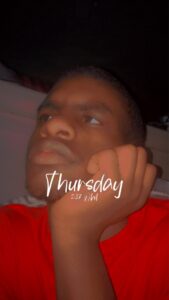

In the case of the performance the percussion professor has curated, John Cage’s “Musicircus,” it’s less about cliffhanger versus cliffhanger and more about which piece of music to listen to, where to stand, and what snippet of sound from here or there might collide with it.
“You’re not sitting in a chair with music thrown at you,” Koshinski said. “You’re immersed in the experience.”
Composers Brian Ferneyhough, John Cage and Roger Reynolds are pictured at the University of California San Diego in 1991. (Bonnie Harkins / loc.gov)
Koshinski has pieced together 400 minutes of the late avant garde composer’s work to create a 90-minute performance featuring musicians from the University of Minnesota Duluth — including the dean of the School of Fine Arts, who is charged with Cage’s most famous piece.
The performance, billed as an installation, is at 7:30 p.m. Monday at the Tweed Museum Art and, in true Cage form, is free and open to the public.
The non-traditional concert will feature between three and 10 pieces played simultaneous from different pockets of the museum, the balcony, the library, the Tuohy Main Gallery: “But What About The Noise of Crumpling Paper” goes from start to finish, while “45′ for a Speaker” begins at the start of the third minute and ends after minute 48, and “In a Landscape” starts after minute 4 and ends after minute 15. Dean Robert Kase will perform “4’33,” which calls for him not to play an instrument at all for 4 minutes, 33 seconds. The ambient sound — foot shuffles, coughs, wrappers — is the music.
Kochinski has made a timeline to accompany the show.
“It’s like a piece within a piece making up an overarching piece,” he said.
‘You won’t hear anything; you’ll hear everything’
Cage was behind the first musicircus, held at the University of Illinois at Urbana-Champaign 52 years ago this month. The idea was to collect a bunch of musicians and have them perform whatever they wanted at the same time in a single venue. The audience was able to move through the university’s Stock Pavilion, catch specific work, or layers of work, or nothing at all.
“You won’t hear anything; you’ll hear everything,” Cage was quoted as saying in a piece on its history in the Guardian.
The musicians blended pop, classical, experimental, whatever.
“The idea is that it’s creating interest with individual pieces and interest in how the pieces coexist in the same space,” Koshinski said.
In 2014, the Guardian posted a story by Peter Dickinson, who had in the 1970s discussed the concept with Cage, including details such as: there should be food and drink, find a variety of participants, 5 hours is a good amount of time, and it should be fun.
Cage died 27 years ago, but the concept lives on.
Video footage from a centennial celebration of John Cage shows performers in corners of the London Coliseum — women in colorful wigs playing hand-clapping games, a man in a suit and hat reading poetry while a woman in an animal mask skulks around him, or a person circling the rim of a wine glass with a finger in front of an audience of at least one. In the background: The plinks of a toy piano, a harp, John Paul Jones of Led Zeppelin playing bass.
But no single piece of video can capture the entire experience — it can be different for every audience member, depending on personal whims.
It can be as much fun for the musicians as it is for the listener. Justin Rubin, professor of theory/composition and organ, has been both.
“I’d say it’s a joy for everyone,” he said. “Who enjoys the meal more, the chef who makes it or the person who eats it. It’s a different kind of enjoyment.”
Music, as life
Koshinski’s take on the musicircus is more organized than some. He has specific songs played at specific times by specific people in specific places in the museum. There are about 25 musicians involved, including Rubin, who has a personal tie to the late composer.
He was at Cage’s wake.
The celebration of his life — described as “not somber and sad” — was held at a loft in lower Manhattan, a space Cage and partner-slash-choreographer Merce Cunningham used for collaborations, according to the professor. The room was filled with the sort of musicians Rubin had read about in his textbooks. Through the course of the event, he ended up singing a folk song along with a traditional Irish musician.
“He wanted his music to represent what it’s like to live,” Rubin said, “not be some formalized thing.”
For this performance, Rubin will perform “A Room” on a prepared piano, outfitted with screws, paperclips, binder clips, pennies and rubber bands to give it a percussive sound.
This is Paula Gudmundson’s first musicircus, though she was involved with a similar style of performance a few years ago at Glensheen. She will perform “Solo for Flute, Alto Flute, and Piccolo,” which includes space for ambient sound, calls for singing and whistle tones, and allows for a lot of flexibility in the order with which it’s played.
She has used Koshinski’s “Choose Your Own Adventure” metaphor to describe the concert to students in her world music class, she said.
“A lot of your experience is going to be only your experience,” Gudmundson said. “What you hear and what you decide to focus on or not focus on, you bring your own perspective to that, too.”
If you go
What: Percussion Ensemble Concert: A John Cage “Musicircus”
When: 7:30 p.m. Nov. 11
Where: Tweed Museum of Art, University of Minnesota Duluth
Tickets: Free, open to the public






